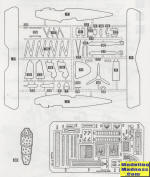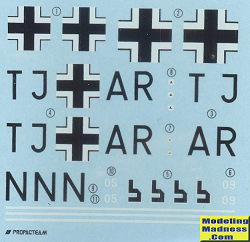
Pavla 1/72 Fi-167
| KIT #: | 72001 |
| PRICE: | $25.00 when new |
| DECALS: | Two options |
| REVIEWER: | Scott Van Aken |
| NOTES: | Short run with vac canopy and photo etch |

| HISTORY |
In early 1937, the Reichsluftfahrtministerium (German Ministry of Aviation) issued a specification for a carrier-based torpedo bomber to operate from Germany's first aircraft carrier, the Graf Zeppelin construction of which had started at the end of 1936. The specification was issued to two aircraft producers, Fieseler and Arado, and demanded an all-metal biplane with a maximum speed of at least 300 km/h (186 mph), a range of at least 1,000 km (631 mi) and capable both of torpedo and dive-bombing. By mid-1938 the Fiesler design proved to be superior to the Arado design, the Ar 195.
The aircraft exceeded by far all requirements, had excellent handling capabilities and could carry about twice the required weapons payload. Like the company's better known Fieseler Fi 156 Storch, the Fi 167 had surprising slow-speed capabilities; under the right conditions, the plane would be able to land almost vertically on a moving aircraft carrier. During a test flight, Gerhard Fieseler himself let the plane drop from 3,050 to 30 metres (10,000 to 100 ft) while staying above the same ground point.
For emergency landings at sea the Fi 167 could jettison its landing gear, and airtight compartments in the lower wing would help the aircraft stay afloat at least long enough for the two-man crew to evacuate.
Two prototypes (Fi 167 V1 and V2) were built, followed by twelve pre-production models (Fi 167 A-0) which had only slight modifications from the prototypes. Its only combat use was with the Croatians in late 1944/early 1945 where one is reputed to have shot down an attacking Mustang.
| THE KIT |
 This
was Pavla's first kit, released in 1995. Typical of pretty much all Czech short
run kits, it had a sprue of injected plastic, a fret of photo etch, and two
clear vacuform canopies. Molding was very fine engraved panel lines and there
was flash on all the plastic parts. Ejector towers were found in all the large
pieces.
This
was Pavla's first kit, released in 1995. Typical of pretty much all Czech short
run kits, it had a sprue of injected plastic, a fret of photo etch, and two
clear vacuform canopies. Molding was very fine engraved panel lines and there
was flash on all the plastic parts. Ejector towers were found in all the large
pieces.
The kit's cockpit is
adequate for the scale and utilizes some of the photo etch for instrument
panels. A cast metal control stick is included. The majority of the p.e. is used
for external detailing and that include s
things like the tail hook, radiator grille and exhaust detailing. Weapons
provided include a torpedo and bombs. Tailplanes, wings, and fin/rudder are a
single piece. Same goes for the wheel/spat pieces and the prop/spinner.
s
things like the tail hook, radiator grille and exhaust detailing. Weapons
provided include a torpedo and bombs. Tailplanes, wings, and fin/rudder are a
single piece. Same goes for the wheel/spat pieces and the prop/spinner.
Instructions are adequate to build the kit and you are provided options for two planes. Both are in RLM 72/73/65 and differ only in aircraft letter. Decals are by Propagteam and should prove to be quite thin.
| CONCLUSIONS |
To my knowledge, this is still the only kit of this aircraft in this scale. You'd have thought that someone else would have done a more modern version, but apparently that is not the case. It is not a kit for beginners, but I've seen it built into a nice model by those with the skills.
| REFERENCE |
https://en.wikipedia.org/wiki/Fieseler_Fi_167
November 2022 Copyright ModelingMadness.com.
All rights reserved. No reproduction in part or in whole without express
permission from the editor. If you would like your product reviewed fairly and
fairly quickly, please
contact
the editor or see other details in the
Note to
Contributors.